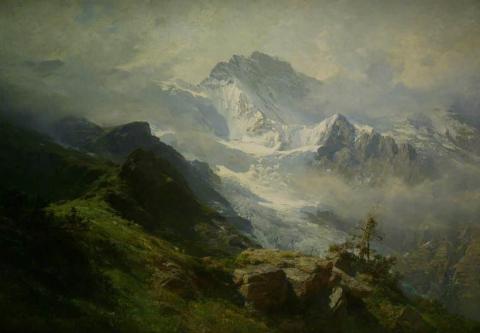The name Jungfrau ("maiden, virgin"), which refers to the highest of the three prominent mountains overlooking the Interlaken region, along with the Mönch ("monk") and the Eiger ("ogre"), is most likely derived from the name Jungfrauenberg given to Wengernalp, the alpine meadow directly facing the huge northern side of the Jungfrau, across the Trummelbach gorge. Wengernalp was so named for the nuns of Interlaken Monastery, its historical owner. Contrary to popular belief, the name did not originate from the appearance of the snow-covered mountain, the latter looking like a veiled woman.
The "virgin" peak was heavily romanticized as "goddess" or "priestess" in late 18th to 19th century Romanticism. Its summit, considered inaccessible, remained untouched until the 19th century. After the first ascent in 1811 by Swiss alpinist Johann Rudolf Meyer, the peak was jokingly referred to as "Mme Meyer" (Mrs. Meyer).
"Interlaken gave Clemens a dramatic view of the pure-white Jungfrau framed by two closer peaks. Moved by this view and the the aptness of the mountain's name, he drew a sexually suggestive picture of the scene in his notebook. Many editions of A Tramp Abroad (1880) contain a toned-down version of this drawing in chapter 32, which is devoted to the mountain."
The Jungfrau ( 13,671 ) , with her dazzling shroud of eternal snow, flanked by the Silberhorn ( 12,156 ′) to the right , and the Schneehorn (11,204′) to the left, now appears in all her majesty. The proportions of the mountain are so gigantic, that the eye in vain attempts to estimate them, and distance seems annihilated by
their vastness . The summits and higher slopes are covered with snow of brilliant purity, while the lower and less precipitous parts present a boundless expanse of snow and glacier . (The highest peak, which is farther to the S. , is visible neither from this spot , nor from Lauterbrunnen . ) The base of the mountain , as far as it is seen, is precipitous.
Bædeker Switzerland (1877) Route 28 page 120
